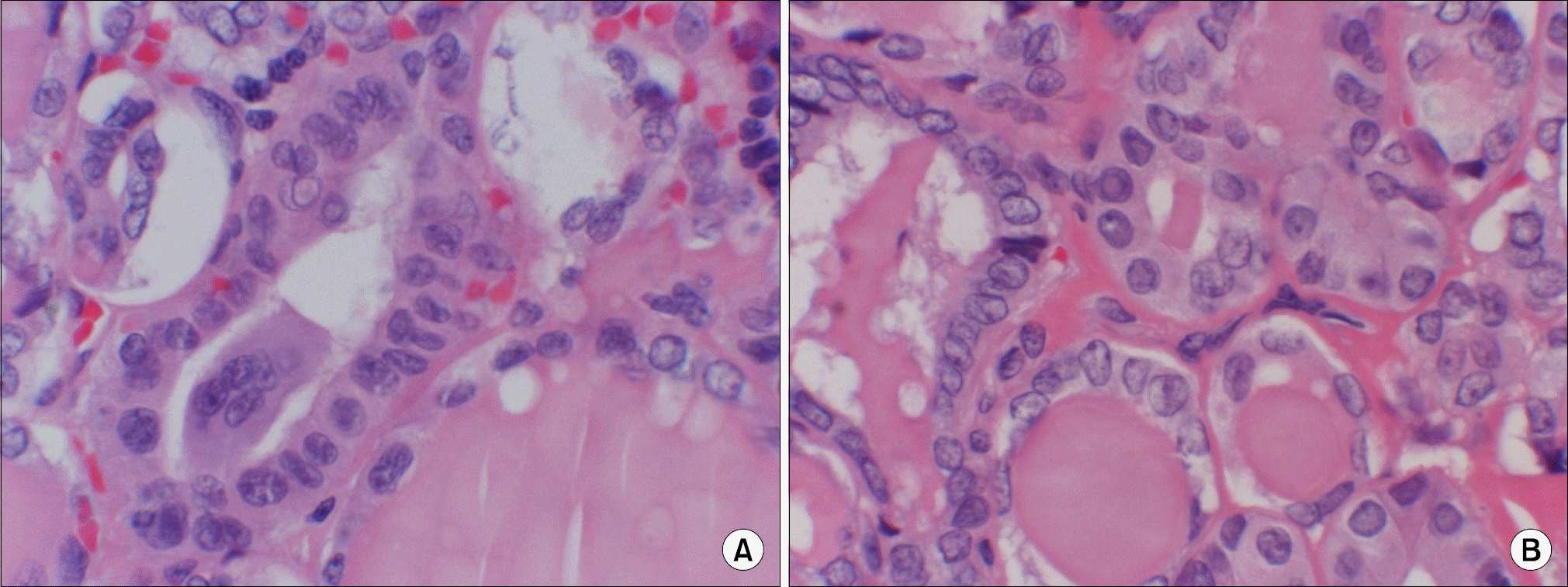Abstract
Purpose:
The follicular variant of papillary thyroid carcinoma (FVPTC) is difficult to diagnose due to pathologic features. There is also debate on the optimal extent of surgery. We separated FVPTC into two groups and compared the clinical features in an attempt to apply the treatment.
Methods:
All 40 patients with FVPTC who were diagnosed between 1990 and 2009 were reviewed and separated into two groups, an encapsulated group and an infiltrative group, based on whether a capsule was formed or infiltration occurred. These two different subtypes of FVPTC were compared on the traits of sensitivity of diagnosis and clinicopathologic features.
Results:
After review by a pathologist, 21 of 40 patients (55%) were found to have encapsulated tumors, and 18 patients (45%) had infiltrative tumors. There was no difference in age, sex, or size. Patients with encapsulated FVPTC had a significantly lower rate of lymph node metastasis (4.5%), multicentric tumors (18.2%), and thyroid capsular invasion (9.1%) compared with the infiltrative tumor group (50%, 50% and 50%, P<0.05). There was no difference in FNA sensitivity between the two groups, but the sensitivity to frozen biopsy was higher in the infiltrative group. There was no recurrence in the encapsulated group, but 4 patients (22.2%) experienced recurrence in the infiltrative group.
Conclusion:
FVPTC can be separated into two subgroups by histologic features, and there are some clinicopathologic differences between the two groups. Patients who had encapsulated FVPTC had a lower rate of lymph node metastasis, multicentric tumors, and thyroid capsular invasion. They also showed a lower rate of recurrence than the infiltrative group. It is suggested that the encapsulated group can be treated with limited surgery and the infiltrative group needs aggressive treatment.
Go to : 
REFERENCES
1.Chen KT., Rosai J. Follicular variant of thyroid papillary carcinoma: a clinicopathologic study of six cases. Am J Surg Pathol. 1977. 1:123–30.
2.Tielens ET., Sherman SI., Hruban RH., Ladenson PW. Follicular variant of papillary thyroid carcinoma. A clinicopathologic study. Cancer. 1994. 73:424–31.

3.Chang HY., Lin JD., Chou SC., Chao TC., Hsueh C. Clinical presentations and outcomes of surgical treatment of follicular variant of the papillary thyroid carcinomas. Jpn J Clin Oncol. 2006. 36:688–93.

4.Kesmodel SB., Terhune KP., Canter RJ., Mandel SJ., LiVolsi VA., Baloch ZW, et al. The diagnostic dilemma of follicular variant of papillary thyroid carcinoma. Surgery. 2003. 134:1005–12.

5.Lee BK., Youn HJ., Jung SH. The pure and follicular variants of papillary thyroid carcinoma: a comparative study of the clinicopathologic features. Korean J Endocrine Surg. 2009. 9:19–23.

6.Lee SC., Yoon JH., Yun JS., Nam KH., Lim CY., Chung WY, et al. Follicular Variant of Papillary Thyroid Carcinoma: Clinical Features and Surgical Strategy. J Korean Surg Soc. 2007. 73:366–71.
7.Lin HS., Komisar A., Opher E., Blaugrund SM. Follicular variant of papillary carcinoma: the diagnostic limitations of preoperative fine-needle aspiration and intraoperative frozen section evaluation. Laryngoscope. 2000. 110:1431–6.

8.Ronald A. DeLellis, Ricardo V. Lloyd, Philipp U. Heitz, Charis Eng. WHO classification of tumours: Pathology and genetics of tumours of endocrine origins. France: IARCPress;2004.
9.Baloch ZW., Gupta PK., Yu GH., Sack MJ., LiVolsi VA. Follicular variant of papillary carcinoma. Cytologic and histologic correlation. Am J Clin Pathol. 1999. 111:216–22.

10.Lang BH., Lo CY., Chan WF., Lam AK., Wan KY. Classical and follicular variant of papillary thyroid carcinoma: a comparative study on clinicopathologic features and long-term outcome. World J Surg. 2006. 30:752–8.

11.Passler C., Prager G., Scheuba C., Niederle BE., Kaserer K., Zettinig G, et al. Follicular variant of papillary thyroid carcinoma: a long-term follow-up. Arch Surg. 2003. 138:1362–6.
12.Burningham AR., Krishnan J., Davidson BJ., Ringel MD., Burman KD. Papillary and follicular variant of papillary carcinoma of the thyroid: Initial presentation and response to therapy. Otolaryngol Head Neck Surg. 2005. 132:840–4.

13.Liu J., Singh B., Tallini G., Carlson DL., Katabi N., Shaha A, et al. Follicular variant of papillary thyroid carcinoma: a clinicopathologic study of a problematic entity. Cancer. 2006. 107:1255–64.
14.Zidan J., Karen D., Stein M., Rosenblatt E., Basher W., Kuten A. Pure versus follicular variant of papillary thyroid carcinoma: clinical features, prognostic factors, treatment, and survival. Cancer. 2003. 97:1181–5.
15.Baloch ZW., LiVolsi VA. Encapsulated follicular variant of papillary thyroid carcinoma with bone metastases. Mod Pathol. 2000. 13:861–5.

16.Guo X., Kleiner D., Fischette M., Merino MJ. Aggressive follicular variant of papillary carcinoma. Mod Pathol. 1999. 12:67A.
17.Chan JK., Tsang WY. Endocrine malignancies that may mimic benign lesions. Semin Diagn Pathol. 1995. 12:45–63.
Go to : 
 | Fig. 1Histologic section of FVPTC. (A) FVPTC shows nuclear features of PTC, (B) FVPTC shows follicle formation. FVPTC = follicular variant of papillary thyroid carcinoma. |
 | Fig. 2Histologic findings according to subgroups of FVPTC. (A) Encapsulated type tumor is surrounded by a capsule, (B) Infiltrative type shows no capsule and invasive pattern. FVPTC = Follicular variant of papillary thyroid carcinoma. |
Table 1.
Comparison of clinicopathological features according to histologic subgroups of the FVPTC
Table 2.
Diagnosis of FNA according to histologic subgroup of FVPTC
Table 3.
Diagnosis of frozen biopsy according to histologic subgroups of FVPTC
Table 4.
Treatment of histologic subgroups of FVPTC




 PDF
PDF ePub
ePub Citation
Citation Print
Print


 XML Download
XML Download